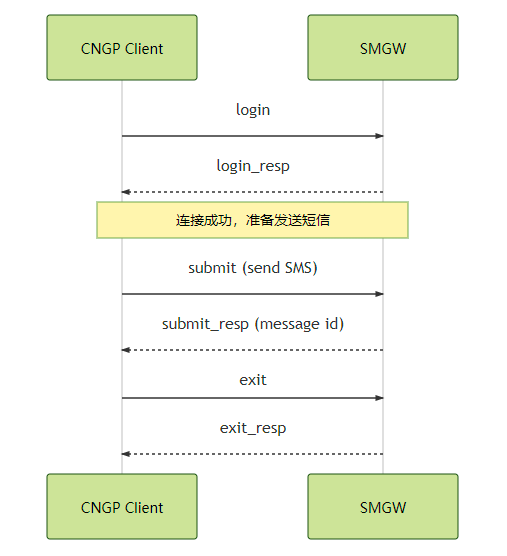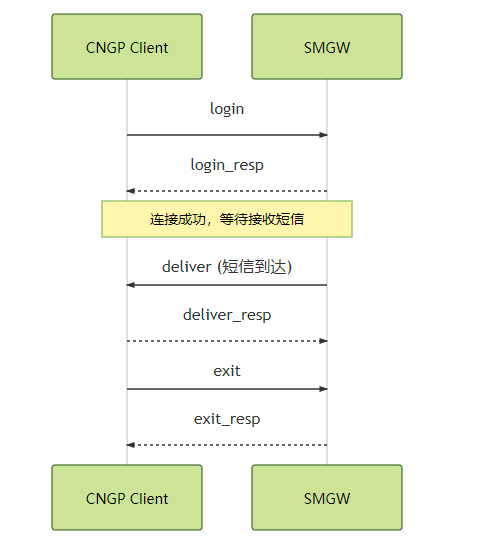教你如何使用Zig实现Cmpp协议
本文分享自华为云社区《华为云短信服务教你用Zig实现Cmpp协议》,作者: 张俭。
引言&协议概述
中国网络通信集团短信网关协议(CNGP)是中国网通为实现短信业务而制定的一种通信协议,全称叫做China Netcom Short Message Gateway Protocol,用于在PHS短消息网关(SMGW)和服务提供商(SP)之间、短消息网关(SMGW)和短消息网关(SMGW)之间通信。
Zig 是一种性能优异、安全性高的系统编程语言,适合用于实现底层网络协议。它提供了强大的类型系统、编译时计算和错误处理机制。
CNGP 协议基于客户端/服务端模型工作。由客户端(短信应用,如手机,应用程序等)先和短信网关(SMGW Short Message Gateway)建立起 TCP 长连接,并使用 CNGP 命令与SMGW进行交互,实现短信的发送和接收。在CNGP协议中,无需同步等待响应就可以发送下一个指令,实现者可以根据自己的需要,实现同步、异步两种消息传输模式,满足不同场景下的性能要求。
时序图
连接成功,发送短信

连接成功,从SMGW接收到短信

协议帧介绍
在CNGP协议中,每个PDU都包含两个部分:CNGP Header和CNGP Body
CNGP Header
Header包含以下字段,大小长度都是4字节
- Total Length:整个PDU的长度,包括Header和Body。
- Command ID:用于标识PDU的类型(例如,Login、Submit等)。
- Common Status:命令状态
- Sequence Id:序列号,用来匹配请求和响应。
使用Zig实现CNGP协议栈里的建立连接
. ├── src │ └── bound_atomic.zig │ ├── cngp_client.zig │ ├── cngp_client_login_example.zig │ ├── constant.zig │ ├── protocol.zig
- bound_atomic.zig:原子递增工具类,用来做SequenceId
- cngp_client.zig:这个文件包含Cngp的定义,该类负责与CNGP服务进行通信,例如建立连接、发送短信等
- cngp_client_login_example.zig:示例代码
- constant.zig:存放常量
- protocol.zig:这个文件包含 CNGP 协议相关的定义和实现,例如协议的命令 ID、PDU 格式等。
constant.zig存放相关commandId
pub const CommandId = enum(u32) {
Login = 0x00000001,
LoginResp = 0x80000001,
Submit = 0x00000002,
SubmitResp = 0x80000002,
Deliver = 0x00000003,
DeliverResp = 0x80000003,
ActiveTest = 0x00000004,
ActiveTestResp = 0x80000004,
Exit = 0x00000006,
ExitResp = 0x80000006,
};
protocol.zig协议编解码
const std = @import("std");
const io = std.io;
const CommandId = @import("constant.zig").CommandId;
pub const CngpLogin = struct {
clientId: []const u8,
authenticatorClient: []const u8,
loginMode: u8,
timeStamp: i32,
version: u8,
pub fn length(self: *const CngpLogin) usize {
return self.clientId.len + self.authenticatorClient.len + 1 + 4 + 1;
}
pub fn encode(self: *const CngpLogin, writer: anytype) !void {
try writer.writeAll(self.clientId);
try writer.writeAll(self.authenticatorClient);
try writer.writeByte(self.loginMode);
try writer.writeIntBig(i32, self.timeStamp);
try writer.writeByte(self.version);
}
};
pub const CngpLoginResp = struct {
authenticatorServer: []const u8,
version: u8,
pub fn decode(buffer: []u8) !CngpLoginResp {
var stream = std.io.fixedBufferStream(buffer);
var reader = stream.reader();
var authenticatorServerBuffer: [16]u8 = undefined;
var fixedSize = try reader.read(&authenticatorServerBuffer);
if (fixedSize != 16) {
return error.InvalidLength;
}
const version = try reader.readByte();
return CngpLoginResp{
.authenticatorServer = authenticatorServerBuffer[0..],
.version = version,
};
}
};
pub const CngpHeader = struct {
total_length: i32,
command_id: CommandId,
command_status: i32,
sequence_id: i32,
};
pub const CngpBody = union(enum) {
Login: CngpLogin,
LoginResp: CngpLoginResp,
};
pub const CngpPdu = struct {
header: CngpHeader,
body: CngpBody,
pub fn length(self: *const CngpPdu) usize {
return 16 + switch (self.body) {
.Login => |login| login.length(),
else => 0,
};
}
pub fn encode(self: *const CngpPdu) ![]u8 {
const len = self.length();
var buffer = try std.heap.page_allocator.alloc(u8, len);
var stream = std.io.fixedBufferStream(buffer);
var writer = stream.writer();
try writer.writeInt(i32, @as(i32, @intCast(len)), .Big);
try writer.writeInt(u32, @intFromEnum(self.header.command_id), .Big);
try writer.writeInt(i32, self.header.command_status, .Big);
try writer.writeInt(i32, self.header.sequence_id, .Big);
switch (self.body) {
.Login => |login| try login.encode(writer),
else => unreachable,
}
return buffer;
}
pub fn decode_login_resp(buffer: []u8) !CngpPdu {
var header: CngpHeader = undefined;
header.total_length = 0;
header.command_id = CommandId.LoginResp;
header.command_status = std.mem.readIntLittle(i32, buffer[8..12]);
header.sequence_id = std.mem.readIntLittle(i32, buffer[12..16]);
const body = try CngpLoginResp.decode(buffer[12..]);
return CngpPdu{
.header = header,
.body = CngpBody{ .LoginResp = body },
};
}
};
利用原子类型实现sequenceId递增
const std = @import("std");
pub const BoundAtomic = struct {
min: i32,
max: i32,
integer: std.atomic.Atomic(i32),
pub fn new(min: i32, max: i32) BoundAtomic {
return BoundAtomic{
.min = min,
.max = max,
.integer = std.atomic.Atomic(i32).init(min),
};
}
pub fn nextVal(self: *BoundAtomic) i32 {
while (true) {
const current = self.integer.load(.SeqCst);
const next = if (current == self.max) self.min else current + 1;
if (self.integer.compareAndSwap(current, next, .SeqCst, .SeqCst) == null) {
return next;
}
}
}
};
实现client以及login方法
const std = @import("std");
const net = std.net;
const CngpBody = @import("protocol.zig").CngpBody;
const CngpLogin = @import("protocol.zig").CngpLogin;
const CngpPdu = @import("protocol.zig").CngpPdu;
const CommandId = @import("constant.zig").CommandId;
const BoundAtomic = @import("bound_atomic.zig").BoundAtomic;
pub const CngpClient = struct {
host: []const u8,
port: u16,
sequenceId: BoundAtomic,
stream: ?std.net.Stream,
pub fn init(host: []const u8, port: u16) CngpClient {
return CngpClient{
.host = host,
.port = port,
.sequenceId = BoundAtomic.new(1, 0x7FFFFFFF),
.stream = null,
};
}
pub fn connect(self: *CngpClient) !void {
const peer = try net.Address.parseIp4(self.host, self.port);
self.stream = try net.tcpConnectToAddress(peer);
}
pub fn login(self: *CngpClient, body: CngpLogin) !CngpPdu {
const sequenceId = self.sequenceId.nextVal();
const pdu = CngpPdu{
.header = .{
.total_length = 0, // Will be calculated in encode method
.command_id = CommandId.Login,
.command_status = 0,
.sequence_id = sequenceId,
},
.body = CngpBody{ .Login = body },
};
const data = try pdu.encode();
if (self.stream) |s| {
const size = try s.write(data);
if (size != data.len) {
return error.WriteFailed;
}
var buffer: [4]u8 = undefined;
const readLengthSize = try s.read(buffer[0..]);
if (readLengthSize != 4) {
return error.ReadFailed;
}
const remainLength = std.mem.readInt(u32, buffer[0..], .Big) - 4;
var responseBuffer = try std.heap.page_allocator.alloc(u8, remainLength);
defer std.heap.page_allocator.free(responseBuffer);
var reader = s.reader();
const readSize = try reader.read(responseBuffer[0..remainLength]);
if (readSize != remainLength) {
return error.ReadFailed;
}
const response = try CngpPdu.decode_login_resp(responseBuffer);
return response;
} else {
return error.UnexpectedNull;
}
}
pub fn close(self: *CngpClient) void {
if (self.stream) |s| {
s.close();
self.stream = null;
}
}
};
运行Example,验证连接成功
const std = @import("std");
const CngpClient = @import("cngp_client.zig").CngpClient;
const CngpLogin = @import("protocol.zig").CngpLogin;
pub fn main() !void {
const host = "127.0.0.1";
const port: u16 = 9890;
var client = CngpClient.init(host, port);
defer client.close();
const clientId = "1234567890";
const authenticatorClient = "1234567890123456";
const loginMode: u8 = 1;
const timeStamp: i32 = 123456789;
const version: u8 = 1;
const loginBody = CngpLogin{
.clientId = clientId,
.authenticatorClient = authenticatorClient,
.loginMode = loginMode,
.timeStamp = timeStamp,
.version = version,
};
try client.connect();
const response = try client.login(loginBody);
try std.io.getStdOut().writer().print("Login response: {}\n", .{response});
}
相关开源项目
- netty-codec-sms 存放各种SMS协议(如cmpp、sgip、smpp)的netty编解码器
- sms-client-java 存放各种SMS协议的Java客户端
- sms-server-java 存放各种SMS协议的Java服务端
- cmpp-python cmpp协议的python实现
- cngp-zig cmpp协议的python实现
- smpp-rust smpp协议的rust实现
总结
本文简单对CNGP协议进行了介绍,并尝试用zig实现协议栈,但实际商用发送短信往往更加复杂,面临诸如流控、运营商对接、传输层安全等问题,可以选择华为云消息&短信(Message & SMS)服务,华为云短信服务是华为云携手全球多家优质运营商和渠道,为企业用户提供的通信服务。企业调用API或使用群发助手,即可使用验证码、通知短信服务。






